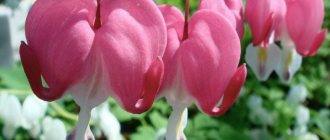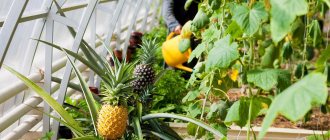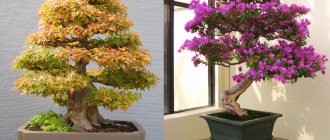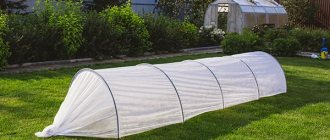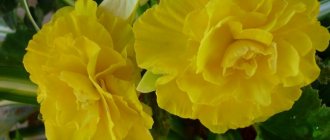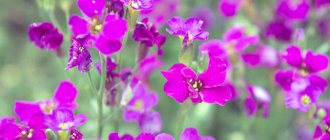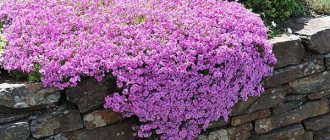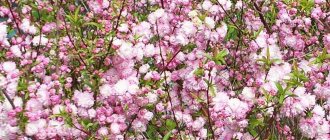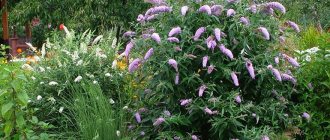Such a beautiful plant as dicentra can decorate any garden. This flower has not lost its relevance over many years and is now actively used in arranging flower beds.
This article will discuss the features of planting dicentra and caring for it.
Description of the flower and its varieties
The plant has several names, the most romantic of which is “Broken Heart”.
Dicentra is distinguished by small heart-shaped flowers. There are a large number of its varieties, which can grow up to 1 m in height or remain very small - less than 15 cm.
Among them are the following varieties:
- Magnificent - a tall flower, reaching 1 m and having inflorescences in the form of a brush. It begins to bloom in May, and this entire period is very short - no more than a month.
- Beautiful - long-flowering, the height of which reaches 40 cm. The flowering period is from June to September.
- Excellent - a plant with blue leaves of a gray tint. It has a variety of inflorescences - from white to pink and purple.
- Klobukonosnaya is a medicinal low-growing dicentra up to 15 cm high with white or pink inflorescences. It has quite poisonous leaves.
- Climbing - annual vine up to 2 m in length with pink or yellow flowers. Blooms in July.
- Canadian is a small-growing plant up to 25 cm high, which has white flowers. Blooms towards mid-April.
All varieties of dicentra, although they differ in color and stem height, will decorate any flower bed. However, its roots are poisonous, and in some species the leaves are also dangerous. Therefore, all work must be carried out wearing protective gloves to prevent skin burns.
Description
Dicentra is a tall perennial plant, its average height is 100 cm. Large pinnately dissected leaves make the bush look like a fern. The top of the leaves is green, the bottom is smooth gray with a grayish-smoky coating. The leaves are placed on petioles up to 12 cm long. The stems are thick, fleshy, branched, densely leafy, most often erect.
Heartbreak Bush
The flowers are medium-large in size, 3–4 cm in diameter, collected in 7–15 pieces in racemes. Brushes, up to 20 cm long, are located at the end of peduncles and in the axils of the leaves at the tops of the shoots. The fruit, in the form of an oblong box 35 mm in length, has a non-falling pistil. The capsule contains smooth round black seeds, 2–8 pieces each.
How to plant a plant correctly
Dicentra is grown in open ground, where it thrives. But at the same time, it is necessary to ensure certain conditions for the best growth:
The plant reacts negatively to bright sunlight, preferring more shaded areas of the garden. In such conditions, the beginning of flowering is slightly delayed, but its duration will be longer.
In direct sunlight, the frequency and duration of flowering decrease sharply, and the plant itself requires regular watering.
Dicentra is planted in fertile soil. First you need to dig holes at the bottom of which drainage is placed. A mixture of soil with compost and lime crumbs is poured on top.
Since dicentra requires abundant watering, it is necessary to prevent the accumulation of water at the roots. Mandatory drainage is used as a means of combating rotting of the root system.
Site preparation and planting
In its natural habitat, dicentra is common on the slopes of the Far East, covered with rubble. She does not like excessively dry climates. On the American continent, varieties that are less demanding on climatic conditions grow.
Dicentra, like many garden flowers, is planted before the onset of cold weather and after the snow melts. Before planting dicentra in spring or autumn, it is necessary to first prepare the soil. For each square meter, add 5 kg of humus and dig it up. Be sure to enrich the soil with mineral fertilizers diluted in water (20 g for every 10 l).
Heavy soils require the addition of lime.
The size of the hole depends on the rhizome, usually half a meter. To prevent water from collecting near the roots of a “broken heart” and causing them to begin to rot, drainage is necessary. To do this, expanded clay is poured into the recess, and ash or sand is mixed into the soil. Since dicentra forms large bushes, the gaps between specimens should be 0.5 meters.
Features of dicentra care
If you choose the right site for planting and carry out the work correctly, your flower will look like the most beautiful photo of the flower. The soil must be fertile, and proper watering should prevent excessive moisture saturation or dry soil.
At the beginning of spring, when the first leaves appear, work is carried out to loosen and mulch the soil. If weather conditions are unfavorable and frosts are observed, then it is advisable to cover the flower, protecting the shoots from freezing.
Inflorescences that have already bloomed should be removed regularly. And in case of complete completion of the flowering cycle, it is necessary to remove the wilted leaves to the stumps.
As a winter shelter in the northern regions of Russia, a layer of peat 6-8 cm thick is used. But in warmer climatic zones, shelter is not provided so that the plant does not rot.
The dicentra flower requires superphosphate feeding. It is applied to the soil in early spring. During the flowering period, at its early stage, the soil is fertilized with nitrogen-rich compounds. This will help to significantly extend the life of bright flowers.
For autumn feeding, the most suitable are humus and infusion of manure.
- Clarkia graceful - varieties and types, care and planting, diseases + 78 photos
- Irises - description of the species, cultivation, reproduction + 102 photos
- Campsis - planting, care, location rules, watering, types of reproduction (67 photos + video)
Biological features
Dicentra or broken heart belongs to the perennial plants of the Dymyankov subfamily of the Poppy family. The plant is frost-resistant, with original flowers that look like a heart divided in half.
It was first described by Carl Linnaeus himself and brought to Europe from Japan in 1816. Many species of dicentra are native to the American continent.
The plant prefers neutral or slightly acidic soils with a rich organic layer that drain well. It does not tolerate stagnant water, which can cause certain areas of the root system to rot.
The leaves of the perennial dicentra are also very decorative. They are pinnately dissected, soft green in color with a bluish tint.
Dicentra reproduction
Let us say right away that propagation by seeds is not advisable. The likelihood of a successful landing is minimal. If the seeds planted in late autumn sprout, the plants will bloom only from the third year, which is quite a long time. And in winter you will have to constantly protect the seedlings with film.
That is why the most preferred methods of propagation are division and cuttings. Dividing an overgrown bush also has sanitary significance. After all, in a strongly overgrown dicentra, the roots are susceptible to rotting. Therefore, work is carried out regularly once every 3 years.
Division is carried out in the spring before flowering or in the autumn after active growth has completed. It is necessary to remove the roots and cut them, separating sections with 3-4 shoots. They are planted in pre-dug holes individually or in a bush.
Cuttings are carried out using young shoots and root shoots about 15 cm long. It is better to plant them in a greenhouse. But in its absence, it can be planted in open ground. But you need to choose areas where the soil will not lose moisture, and the planting itself is protected with film.
Cuttings that have taken root can be planted in a flowerbed next spring.
- Bacopa - description of the species, cultivation, care, reproduction + 74 photos
Garden hibiscus - types, description, planting, care and propagation + 69 photos
- Celosia - growing from seeds and seedlings, planting in the ground and care rules + 80 photos
Types and popular varieties of dicentra
There are about ten, according to some sources, and twenty, according to others, types of dicentra, of which approximately half are cultivated in gardens. Most often found in flower beds is the magnificent, beautiful and wandering dicentra.
The magnificent dicentra (lat. Dicentra spectabilis) is considered the most capricious, although the most common variety. The description of the plant fully corresponds to its name: a powerful tall (up to 1.5 m) and branched bush, strewn with large, bright flowers. The peak growing season for Dicentra splendor occurs in May-June. The most popular varieties include:
- "Gold Heart" The main feature of this variety is its unusual bright yellow leaves. Its advantage is high frost resistance and a very long flowering period.
- "Alba" (Alba). Low bushes with white “hearts”.
- "Valentine" (Valentine). Elegant purple flowers with a white center against a background of openwork greenery.
- "Pearl Drops" Bluish-green leaves and delicate pendulous inflorescences of a creamy pink hue.
- "White Gold" (White-gold). An unusual variety with white inflorescences and yellowish-green foliage.
- "Amore Pink" (Pink Love). Compact, abundantly flowering perennial with soft pink flowers of an original shape.
D. “Valentine”, D. “White Gold”, D. “Amore Pink”
If you are interested in low, graceful crops, be sure to pay attention to the beautiful dicentra (lat. Dicentra formosa). This species is distinguished by relatively small, elongated flowers and a neat habit. Most gardeners prefer the following varieties:
- "Spring Magic" The carved leaves of this variety will be pubescent and have an unusual silvery color.
- "Aurora" (Aurora). Variety with snow-white flowers.
- "King of Hearts" A medium-sized bush with bluish-green foliage and bright purple flowers.
- "Bacchanal" (Bacchanalia). A popular variety with gray-green leaves and short racemose inflorescences of a crimson hue.
D. “Spring Magic”, D. “Aurora”, D. “Bacchanal”
One of the most unusual species is, of course, Dicentra peregrina, which covers the foothills of Altai and Tibet. This creeping, vine-like plant will delight you with a very long flowering period. But, unfortunately, in our latitudes it lives no more than one year. Some of the most common varieties of dicentra vagrant are:
- "Rudolph" (Rudolph). A low growing bush topped with pastel pink flowers.
- "Hien" Its main difference is its magnificent purple-cherry flowers with a narrow white border.
- "Alba" (Alba). Bright white inflorescences against a background of rich green foliage.
D. “Rudolph”, D. “Hien”, D. “Alba”
More rare, but gradually gaining popularity species are:
- Dicentra cuccularia (lat. Dicentra cuccularia). It has white, pink or deep yellow flowers with long spurs. The name of the species comes from a rhizome consisting of small nodules.
- Dicentra chrysanta (lat. Dicentra chrysanta). Tall (up to 1.3 m) heat-loving variety with bright yellow flowers. It is whimsical and therefore rarely found in culture.
- Dicentra exceptional, also called excellent (Latin: Dicentra eximia). A beautiful medium-sized plant with fleshy stems and bright pink flowers.
- Canadian dicentra (lat. Dicentra canadensis). It resembles the hooded plant, but stands out for its milky-greenish color of flowers. One of the earliest flowering species.
D. capillary, D. exceptional, D. canadian
Dicentra in landscape design
Some time ago, dicentra almost disappeared from front gardens: the bright perennial went out of fashion and was simply forgotten about. However, recently, landscape designers, and after them gardeners, remembered the spectacular plant. Now the “broken heart” grows in many gardens and decorates a huge number of flower beds.
Dicentra gets along well with any plants. Its flowering period takes about one month, so when creating a mixborder, it is more advisable to plant dicentra along with calendula, ageratum or mallow, which will bloom until November. Very often, the perennial is used to decorate shady compositions, in which its neighbors are usually various ferns, telekia or hostas.
Compositions from different varieties of dicentra, as well as borders where it is combined with forget-me-nots or primrose, also look very unusual. Such flower beds usually decorate slopes covered with crushed stone or brick along paths.
In the wild, the plant covers mountain plateaus and mounds, so low varieties of the perennial look authentic in rock gardens.
In general, tall species and varieties are best used as a bright spring accent in a flower bed, and medium-sized and low ones are best used as filling in empty areas.
Photos of dicenters
Pests and diseases
Although this plant is very strong, diseases and pests still plague the center.
Among the pests, it is worth noting aphids and snails. Prevention against snails is very simple. It is enough to mulch the soil under the plants with sawdust, and the mollusks will stop crawling into your flowerbed or garden bed. Wood waste is very prickly for them.
Spraying with a soap-ash solution helps against aphids; in addition, tinctures of onion peel, garlic, dandelion, marigold, lemon zest and others help.
Among the diseases, dicentra is affected by ring spot on leaves and tobacco mosaic virus. For prevention, the soil under the plants must be treated with formaldehyde. And on healthy, cultivated and mulched soil there will be no diseases.
The dicentra should be kept in one place without transplantation for more than five years, then it is dug up, divided and transplanted to a new place.
3.Flowering time
The exact timing of flowering will depend on external factors and the specific variety. The first buds of dicentra may appear in the spring - in May, but individual plants will decorate themselves with flowers in the summer months - until mid-July.
Sometimes flower stalks can appear even in the second half of summer - early autumn - most often this is a beautiful dicentra.
↑ Up,
Blooming from the base of long peduncles to the tops, the buds open sequentially, and therefore the flowering period can be quite long - up to 1.5 months.
With timely pruning, a second wave of flowering may occur in the autumn months.
↑ Up,
Fertilizer and feeding
In early spring, dicentra needs superphosphate fertilizer. And when the plant blooms, it is recommended to feed the bushes with nitrogen-containing fertilizers, which can extend the flowering time of the dicentra. But in the fall, humus is fertilized under each bush and the roots of the plant are watered with infusion of manure. If you care for the dicentra correctly, it will grow into a large and beautiful bush.
It is advisable to feed the plant both in spring and autumn
How to transplant dicentra (video)
Recommendations:
- In the second year, some of the roots rise above the ground; they must be covered with soil. It is better to deepen the bush. The process is complex and requires accuracy.
- Use superphosphate as a fertilizer. It will enhance flowering.
- At the end of flowering, nitrogen-containing mixtures are used for fertilizer.
- If there is a sudden cold snap, you should consider protecting the plant. Select a covering material, cover the root system with sawdust or leaves. As soon as the frost subsides, the covering is removed from the roots, and the flower may die.
- During the development of the bush, constantly cut off wilted branches and inflorescences.
- In autumn, the entire above-ground part is cut off, leaving low stems - up to 10 cm.
The legends about the power of the dicentra are so interesting that you want to experience them for yourself. A flower of charm and tenderness, pressed to the chest, can fulfill a woman’s desire to find love and reciprocity. The flowering of the bush will help you gain a lot of positive emotions and joyful feelings. Therefore, you should try and plant a broken heart on the plot, enjoy the aroma, wait for magic and miracles.
Where to plant dicentra in the garden: choosing a location
The planting location can be either sunny or shady. However, the plant still feels better in a semi-shaded place, where it will grow more intensively and more beautifully, and bloom longer.
The perennial plant is most comfortable in light, loose, fertile, moderately moist and well-drained soil. Dicentra loves sandy soil, so it is advisable to plant it on sandy loam soil or simply add river sand to the flower garden for digging. That is, at such a place the dicenter can show maximum decorativeness.
Important! You cannot plant a perennial in an area where moisture stagnates or the soil is excessively waterlogged. After all, dicentra does not tolerate stagnant water.
Dicentra looks great both in single plantings and in group plantings. A very beautiful combination in a flower garden with primrose, forget-me-not, and anemone.
Advice! If the soil on your site does not sufficiently meet the specified requirements, then it is useful to dig up the soil with a shovel with fertilizer (4 kg of humus per 1 square meter, a bucket of sand per 1 sq.m., as well as complex mineral fertilizer) a season before planting.
